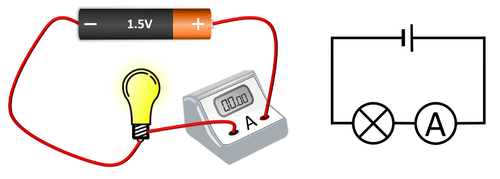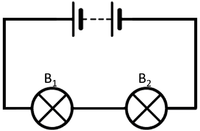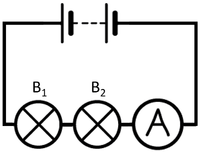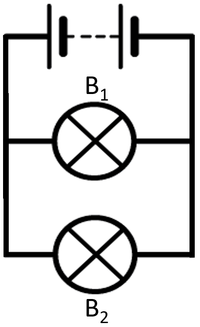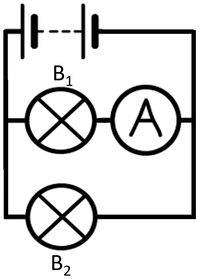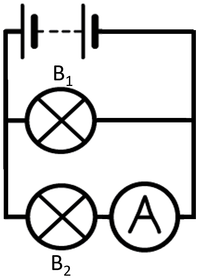Difference between revisions of "Ammeter"
(→About Ammeters) |
(→Key Stage 4) |
||
| Line 49: | Line 49: | ||
|[[File:CircuitDiagramBatteryBulbBulbAmmeterParallel.png|center|200px]] | |[[File:CircuitDiagramBatteryBulbBulbAmmeterParallel.png|center|200px]] | ||
|} | |} | ||
| + | |||
| + | ===References=== | ||
| + | ====AQA==== | ||
| + | :[https://www.amazon.co.uk/gp/product/0008158770/ref=as_li_tl?ie=UTF8&camp=1634&creative=6738&creativeASIN=0008158770&linkCode=as2&tag=nrjc-21&linkId=ec31595e720e1529e49876c3866fff6e ''Ammeter, pages 52-6, GCSE Physics; Student Book, Collins, AQA'] | ||
| + | :[https://www.amazon.co.uk/gp/product/1471851370/ref=as_li_tl?ie=UTF8&camp=1634&creative=6738&creativeASIN=1471851370&linkCode=as2&tag=nrjc-21&linkId=01c69b0ae058f809cf636033e6ba793e ''Ammeters, page 41, GCSE Physics, Hodder, AQA'] | ||
| + | :[https://www.amazon.co.uk/gp/product/019835939X/ref=as_li_tl?ie=UTF8&camp=1634&creative=6738&creativeASIN=019835939X&linkCode=as2&tag=nrjc-21&linkId=57e96876985fc39b1a3d8a3e3dc238b6 ''Ammeters, page 52, GCSE Physics; Third Edition, Oxford University Press, AQA'] | ||
| + | :[https://www.amazon.co.uk/gp/product/1782945598/ref=as_li_tl?ie=UTF8&camp=1634&creative=6738&creativeASIN=1782945598&linkCode=as2&tag=nrjc-21&linkId=ad276ad49df77ab4b40ab4fd0fe09675 ''Ammeters, pages 180, 239, GCSE Combined Science; The Revision Guide, CGP, AQA'] | ||
| + | :[https://www.amazon.co.uk/gp/product/178294558X/ref=as_li_tl?ie=UTF8&camp=1634&creative=6738&creativeASIN=178294558X&linkCode=as2&tag=nrjc-21&linkId=f0dfb66dafcb0c6e9449e7b1a4ae1ac15 ''Ammeters, pages 25, 106, GCSE Physics; The Revision Guide, CGP, AQA'] | ||
| + | :[https://www.amazon.co.uk/gp/product/1471851354/ref=as_li_tl?ie=UTF8&camp=1634&creative=6738&creativeASIN=1471851354&linkCode=as2&tag=nrjc-21&linkId=9012a0d354024419214fb3ad5ac44ba0 ''Ammeters, pages 293, 296, GCSE Combined Science Trilogy 1, Hodder, AQA'] | ||
| + | :[https://www.amazon.co.uk/gp/product/1782946403/ref=as_li_tl?ie=UTF8&camp=1634&creative=6738&creativeASIN=1782946403&linkCode=as2&tag=nrjc-21&linkId=32a0abb60dff015b15b50e9b1d7b4644 ''Ammeters, pages 60, 61, 235, GCSE Combined Science Trilogy; Physics, CGP, AQA'] | ||
| + | :[https://www.amazon.co.uk/gp/product/1782945970/ref=as_li_tl?ie=UTF8&camp=1634&creative=6738&creativeASIN=1782945970&linkCode=as2&tag=nrjc-21&linkId=a120d24dcc7cc7a58192069a3aafc1d2 ''Ammeters, pages 62, 63, 331, GCSE Physics; The Complete 9-1 Course for AQA, CGP, AQA'] | ||
| + | :[https://www.amazon.co.uk/gp/product/1471851370/ref=as_li_tl?ie=UTF8&camp=1634&creative=6738&creativeASIN=1471851370&linkCode=as2&tag=nrjc-21&linkId=01c69b0ae058f809cf636033e6ba793e ''Ammeters; circuit symbol, page 38, GCSE Physics, Hodder, AQA'] | ||
Revision as of 18:18, 27 October 2019
Contents
Key Stage 3
Meaning

A picture showing an analogue ammeter.
An ammeter is a measuring device used to measure electrical current.
About Ammeters
- Ammeters are added in series to a circuit to find the current flowing through the circuit.
- An ideal ammeter has zero resistance because otherwise adding an ammeter to a circuit would change the current.
- Ammeters can be analogue with a needle pointing to numbers on a dial or it can be digital with a number display.
| An ammeter placed in series with a bulb. |
Key Stage 4
Meaning
An ammeter is a measuring device used to measure electrical current.
About Ammeters
- Ammeters are added in series to a circuit to find the current flowing through the circuit.
- An ideal ammeter has zero resistance because otherwise adding an ammeter to a circuit would change the current.
- Ammeters can be analogue with a needle pointing to numbers on a dial or it can be digital with a number display.
| To measure the current through bulb 1 the ammeter can be placed anywhere in this series circuit. | To measure the current through bulb 2 the ammeter can be placed anywhere in this series circuit. |
| To measure the current through bulb 1 the ammeter must be placed in series with bulb 1. | To measure the current through bulb 2 the ammeter must be placed in series with bulb 2. |
References
AQA
- Ammeter, pages 52-6, GCSE Physics; Student Book, Collins, AQA'
- Ammeters, page 41, GCSE Physics, Hodder, AQA'
- Ammeters, page 52, GCSE Physics; Third Edition, Oxford University Press, AQA'
- Ammeters, pages 180, 239, GCSE Combined Science; The Revision Guide, CGP, AQA'
- Ammeters, pages 25, 106, GCSE Physics; The Revision Guide, CGP, AQA'
- Ammeters, pages 293, 296, GCSE Combined Science Trilogy 1, Hodder, AQA'
- Ammeters, pages 60, 61, 235, GCSE Combined Science Trilogy; Physics, CGP, AQA'
- Ammeters, pages 62, 63, 331, GCSE Physics; The Complete 9-1 Course for AQA, CGP, AQA'
- Ammeters; circuit symbol, page 38, GCSE Physics, Hodder, AQA'
